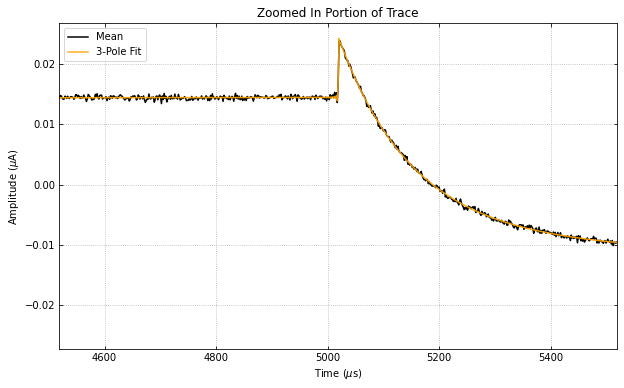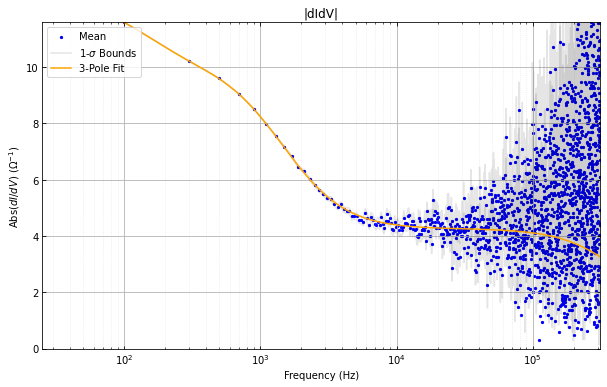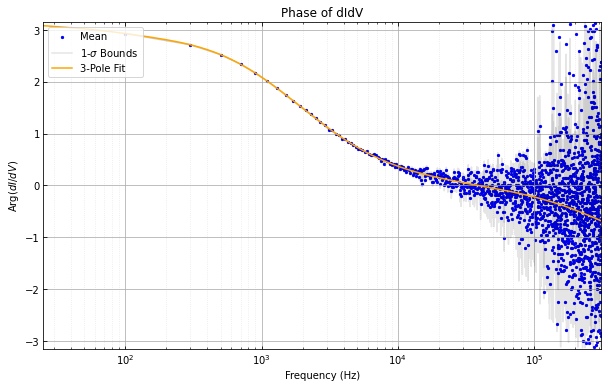Example Code for using the \(\partial I/ \partial V\) Fitting Routines¶
Import the needed packages to run the test script.
import qetpy as qp
import matplotlib.pyplot as plt
import numpy as np
np.random.seed(0)
%matplotlib inline
Set all of the necessary parameters for initalizing the class, as well as specify the TES parameters that we will use to simulate a TES square wave response.
# Setting various parameters that are specific to the dataset
rsh = 5e-3
rbias_sg = 20000
fs = 625e3
sgfreq = 100
sgamp = 0.009381 / rbias_sg
rfb = 5000
loopgain = 2.4
drivergain = 4
adcpervolt = 65536 / 2
tracegain = rfb * loopgain * drivergain * adcpervolt
true_params = {
'rsh': rsh,
'rp': 0.006,
'r0': 0.0756,
'beta': 2,
'l': 10,
'L': 1e-7,
'tau0': 500e-6,
'gratio': 0.5,
'tau3': 1e-3,
}
Make simulated data, where we simply have a TES square response with added white noise (not exactly physical, but this is just a demo!).
psd_test = np.ones(int(4 * fs / sgfreq)) / tracegain**2 / 1e4
rawnoise = qp.gen_noise(psd_test, fs=fs, ntraces=300)
t = np.arange(rawnoise.shape[-1]) / fs
didv_response = qp.squarewaveresponse(
t, sgamp, sgfreq, **true_params,
)
rawtraces = didv_response + rawnoise
fig, ax = plt.subplots(figsize=(10, 6))
ax.plot(
t * 1e3,
rawtraces.mean(axis=0) * 1e6,
color='gray',
label='Mean of Simulated Data',
)
ax.plot(
t * 1e3,
didv_response * 1e6,
color='k',
label='True Response',
)
ax.set_ylabel('Amplitude [μA]')
ax.set_xlabel('Time [ms]')
ax.set_title('Simulated Data')
ax.set_xlim(0, 40)
ax.legend(loc='lower right', edgecolor='k', framealpha=1)
fig.tight_layout()
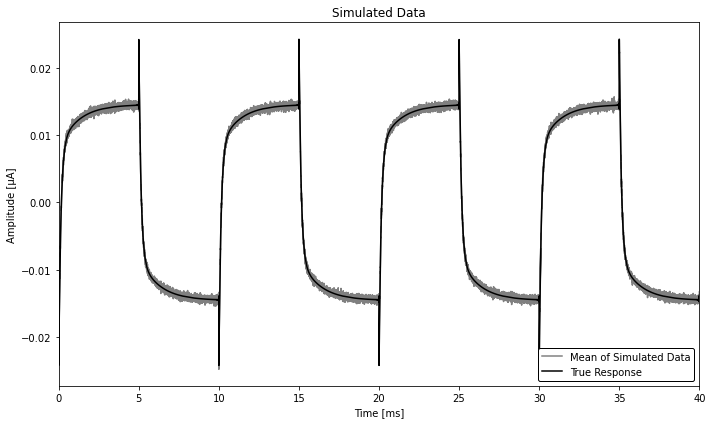
Using the DIDV Class¶
Run the processing package on the data.
Note that the parameterization used by this class is such that there are no degenerate fitting parameters. Depending on the fit, the model changes.
From the Notes in DIDV.dofit:
Notes
-----
Depending on the fit, there are three possible models to be
used with different parameterizations:
1-pole model
- has the form:
dV/dI = A * (1.0 + 2.0j * pi * freq * tau2)
2-pole model
- has the form:
dV/dI = A * (1.0 + 2.0j * pi * freq * tau2)
+ B / (1.0 + 2.0j * pi * freq * tau1)
3-pole model
- note the placement of the parentheses in the last term of
this model, such that pole related to `C` is in the
denominator of the `B` term
- has the form:
dV/dI = A * (1.0 + 2.0j * pi * freq * tau2)
+ B / (1.0 + 2.0j * pi * freq * tau1
- C / (1.0 + 2.0j * pi * freq * tau3))
didvfit = qp.DIDV(
rawtraces,
fs,
sgfreq,
sgamp,
rsh,
tracegain=1.0,
r0=true_params['r0'], # the expected r0 should be specified if the estimated small-signal parameters are desired (otherwise they will be nonsensical)
rp=true_params['rp'], # the expected rp should be specified if the estimated small-signal parameters are desired (otherwise they will be nonsensical)
dt0=-1e-6, # a good estimate of the time shift value will likely speed up the fit/improve accuracy
add180phase=False, # if the fits aren't working, set this to True to see if the square wave is off by half a period
)
# didvfit.dofit(1) # we skip the 1-pole fit, as it takes a long time to run due to being a bad model.
didvfit.dofit(2)
didvfit.dofit(3)
Let’s look at the fit parameters for the fits.
result2 = didvfit.fitresult(2)
result3 = didvfit.fitresult(3)
Each of these result variables are dictionaries that contain various
information that have to do with the fits, as shown by looking at the
keys.
result3.keys()
dict_keys(['params', 'cov', 'errors', 'smallsignalparams', 'falltimes', 'cost', 'didv0'])
'params'contains the fitted parameters from the minimization method (in the case ofDIDV, this is in the parameterization used by the fitting algorithm)'cov'contains the corresponding covariance matrix'errors'is simply the square root of the diagonal of the covariance matrix'smallsignalparams'contains the corresponding parameters in the small-signal parameterization of the complex impedance, as shown by Irwin and Hilton for the two-pole model and Maasilta for the three-pole model.'falltimes'contains the physical fall times of the specified model'cost'is the value of the chi-square at the fitted values'didv0'is the zero frequency component of the \(\partial I / \partial V\) fitted model.
We can also use qetpy.complexadmittance along with the
'smallsignalparams' dictionary to quickly calculate the
zero-frequency component of the \(\partial I / \partial V\).
print(f"The 2-pole dI/dV(0) is: {result2['didv0']:.2f}")
print(f"The 3-pole dI/dV(0) is: {result3['didv0']:.2f}")
The 2-pole dI/dV(0) is: -11.61
The 3-pole dI/dV(0) is: -12.43
There are a handful of plotting functions that can be used to plot the results, where we use two of them below.
# didvfit.plot_full_trace()
# didvfit.plot_single_period_of_trace()
# didvfit.plot_didv_flipped()
# didvfit.plot_re_vs_im_dvdi()
# didvfit.plot_re_im_didv()
didvfit.plot_zoomed_in_trace(zoomfactor=0.1)
didvfit.plot_abs_phase_didv()
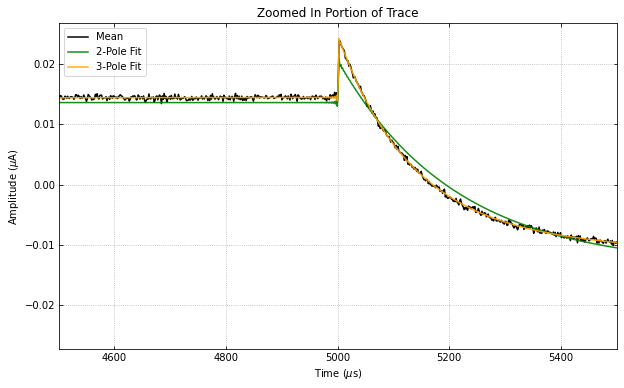
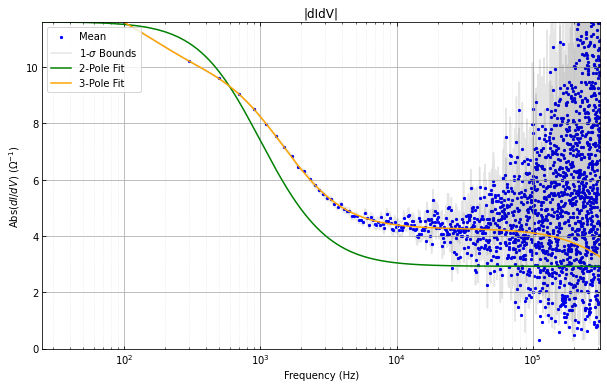
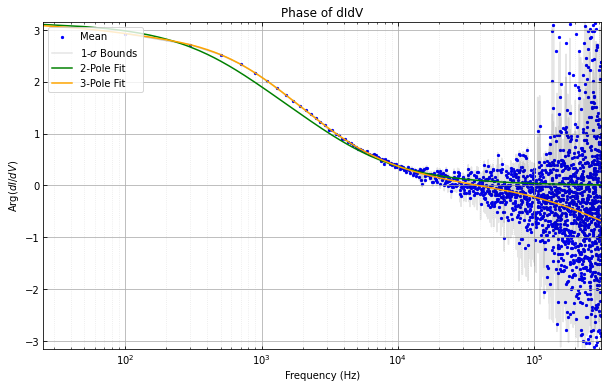
Advanced Usage: Using DIDVPriors¶
There is a separate class, which uses the small-signal parameterization
to do the fitting. However, the small-signal parameterization has more
parameters than degrees of freedom, resulting in degeneracy in the model
(as opposed to the models used by DIDV, which are non-degenerate).
However, if the uncertainties on the small-signal parameters are
desired, then the DIDVPriors class is recommended, which uses a
prior probability distribution on known values to remove the
degeneracies.
The initialization of the class is quite similar.
didvfitprior = qp.DIDVPriors(
rawtraces,
fs,
sgfreq,
sgamp,
rsh,
tracegain=1.0,
dt0=-18.8e-6,
)
Running the fit requires more information, as we need to know the prior
probability distribution. In this case, priors and priorscov are
additionally required in the dofit method.
priorsis a 1-d ndarray that contains the prior known values of the specified model.priorscovis a 2-d ndarray that contains the corresponding covariance matrix of the values inpriorsFor any values that are not known, the corresponding elements should be set to zero for both
priorsandpriorscov.
The values of priors and priorscov for each model are: - 1-pole
- priors is a 1-d array of length 4 containing (rsh, rp,
L, dt) (in that order!) - priorscov is a 2-d array of
shape (4, 4) containing the corresponding covariance matrix - 2-pole -
priors is a 1-d array of length 8 containing (rsh, rp,
r0, beta, l, L, tau0, dt) (in that order!) -
priorscov is a 2-d array of shape (8, 8) containing the
corresponding covariance matrix - 3-pole - priors is a 1-d array of
length 10 containing (rsh, rp, r0, beta, l, L,
tau0, gratio, tau3, dt) (in that order!) -
priorscov is a 2-d array of shape (10, 10) containing the
corresponding covariance matrix
We note that, the more parameters passed to the fitting algorithm, the ‘better’ the result will be, as degeneracies will be removed.
At minimum, we recommend passing rsh, rp, and r0 (the last
of which should not be passed to the 1-pole fit).
Below, we show an example of using the fitting algorithm for the 3-pole
case, assuming 10% errors on rsh, rp, and r0.
priors = np.zeros(10)
priorscov = np.zeros((10, 10))
priors[0] = true_params['rsh']
priorscov[0, 0] = (0.1 * priors[0])**2
priors[1] = true_params['rp']
priorscov[1, 1] = (0.1 * priors[1])**2
priors[2] = true_params['r0']
priorscov[2, 2] = (0.1 * priors[2])**2
didvfitprior.dofit(3, priors, priorscov)
Extracting the results of the fit is very similar, where a dictionary is
returned, which has slightly different form than DIDV.
result3_priors = didvfitprior.fitresult(3)
result3_priors.keys()
dict_keys(['params', 'cov', 'errors', 'falltimes', 'cost', 'didv0', 'priors', 'priorscov'])
'params'contains the fitted parameters from the minimization method (which are the small-signal parameters), as shown by Irwin and Hilton for the two-pole model and Maasilta for the three-pole model.'cov'contains the corresponding covariance matrix'errors'is simply the square root of the diagonal of the covariance matrix'falltimes'contains the physical fall times of the specified model'cost'is the value of the chi-square at the fitted values'didv0'is the zero frequency component of the \(\partial I / \partial V\) fitted model.'priors'simply contains the inputted priors'priorscov'simply contains the inputted priors covariance matrix
Note the lack of smallsignalparams, as compared to DIDV. Since
we fit directly using the small-signal parameterization, there is no
need to convert parameters.
We can again calculate the zero-frequency component of the
\(\partial I / \partial V\) using qetpy.complexadmittance, this
time using the 'params' key in the results dictionary.
print(f"The 3-pole dI/dV(0) is: {result3_priors['didv0']:.2f}")
The 3-pole dI/dV(0) is: -12.43
This class uses the same plotting functions as DIDV, such that they
can be called in the same way.
didvfitprior.plot_zoomed_in_trace(zoomfactor=0.1)
didvfitprior.plot_abs_phase_didv()
